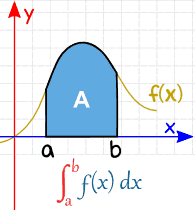The value of the integral \(∫_{\frac 12}^2 \frac{tan^{-1}x}{x}dx\) is equal to
- $ \frac{π}2 log_e2$
- $ 2 log_e2$
- $ \frac{1}2 log_e2$
- $ \frac{π}4 log_e2$
The Correct Option is A
Solution and Explanation
(A)The given integral is: \[ I = \int_{1/2}^2 \frac{\tan^{-1} x}{x} \, dx. \] (B)Use the substitution \( x = \frac{1}{t} \), so \( dx = -\frac{1}{t^2} dt \). The limits of integration change as follows: \[ x = \frac{1}{2} \implies t = 2, \quad x = 2 \implies t = \frac{1}{2}. \] Substituting, the integral becomes: \[ I = \int_{2}^{1/2} \frac{\tan^{-1}\left(\frac{1}{t}\right)}{\frac{1}{t}} \cdot \left(-\frac{1}{t^2}\right) dt. \] (C)Simplify: \[ I = \int_{1/2}^2 \frac{\tan^{-1}\left(\frac{1}{t}\right)}{t} dt. \] (D)Add the original integral and its substitution: \[ 2I = \int_{1/2}^2 \frac{\tan^{-1} x}{x} \, dx + \int_{1/2}^2 \frac{\tan^{-1}\left(\frac{1}{x}\right)}{x} \, dx. \] (E)Use the property \( \tan^{-1} x + \tan^{-1}\left(\frac{1}{x}\right) = \frac{\pi}{2} \) for \( x > 0 \). Thus: \[ 2I = \int_{1/2}^2 \frac{\frac{\pi}{2}}{x} \, dx. \] (F) Simplify: \[ 2I = \frac{\pi}{2} \int_{1/2}^2 \frac{1}{x} \, dx. \] The integral of \( \frac{1}{x} \) is \( \log_e x \): \[ 2I = \frac{\pi}{2} \left[\log_e x\right]_{1/2}^2. \] (G) Evaluate: \[ 2I = \frac{\pi}{2} \left(\log_e 2 - \log_e \frac{1}{2}\right). \] Simplify \( \log_e \frac{1}{2} = -\log_e 2 \): \[ 2I = \frac{\pi}{2} \left(\log_e 2 - (-\log_e 2)\right) = \frac{\pi}{2} (2\log_e 2). \] Divide by 2: \[ I = \frac{\pi}{2} \log_e 2. \]
Top Questions on Definite Integral
- Evaluate the definite integral: \( \int_{-2}^{2} |x^2 - x - 2| \, dx \)
- MHT CET - 2025
- Mathematics
- Definite Integral
- The value of the integral \[ \int_{-1}^{2} \log_e \left( x + \sqrt{x^2 + 1} \right) \, dx \] is:
- JEE Main - 2024
- Mathematics
- Definite Integral
The value \( 9 \int_{0}^{9} \left\lfloor \frac{10x}{x+1} \right\rfloor \, dx \), where \( \left\lfloor t \right\rfloor \) denotes the greatest integer less than or equal to \( t \), is ________.
- JEE Main - 2024
- Mathematics
- Definite Integral
- The value of \(\lim_{{n \to \infty}} \sum_{{k=1}}^{n} \frac{n^3}{{(n^2 + k^2)(n^2 + 3k^2)}}\) is
- JEE Main - 2024
- Mathematics
- Definite Integral
If the value of the integral
\[ \int_{-\frac{\pi}{2}}^{\frac{\pi}{2}} \left( \frac{x^2 \cos x}{1 + \pi^x} + \frac{1 + \sin^2 x}{1 + e^{\sin^x 2023}} \right) dx = \frac{\pi}{4} (\pi + a) - 2, \]
then the value of \(a\) is:
- JEE Main - 2024
- Mathematics
- Definite Integral
Questions Asked in JEE Main exam
- In a group of 3 girls and 4 boys, there are two boys \( B_1 \) and \( B_2 \). The number of ways in which these girls and boys can stand in a queue such that all the girls stand together, all the boys stand together, but \( B_1 \) and \( B_2 \) are not adjacent to each other, is:
- JEE Main - 2025
- Permutations
- A group 15 element forms \( d\pi - d\pi \) bond with transition metals. It also forms a hydride, which is the strongest base among the hydrides of other group members that form \( d\pi - d\pi \) bonds. The atomic number of the element is ________________________.
- JEE Main - 2025
- Chemical bonding and molecular structure
- The value of \( (\sin 70^\circ)(\cot 10^\circ \cot 70^\circ - 1) \) is:
- JEE Main - 2025
- Trigonometric Identities
- Match List-I with List-II.

- JEE Main - 2025
- Dimensional analysis
Nature of compounds TeO₂ and TeH₂ is___________ and ______________respectively.
- JEE Main - 2025
- Inorganic chemistry
Concepts Used:
Definite Integral
Definite integral is an operation on functions which approximates the sum of the values (of the function) weighted by the length (or measure) of the intervals for which the function takes that value.
Definite integrals - Important Formulae Handbook
A real valued function being evaluated (integrated) over the closed interval [a, b] is written as :
\(\int_{a}^{b}f(x)dx\)
Definite integrals have a lot of applications. Its main application is that it is used to find out the area under the curve of a function, as shown below:
